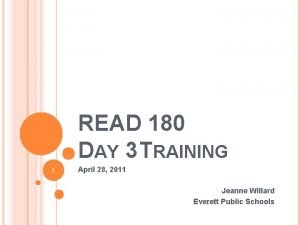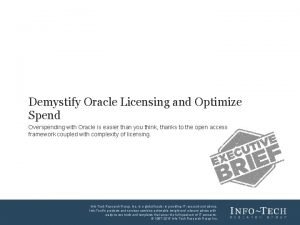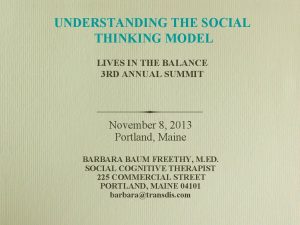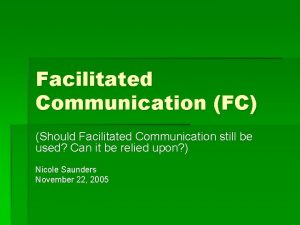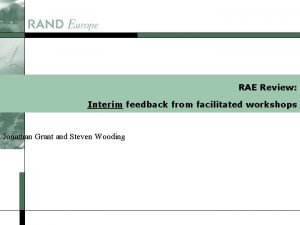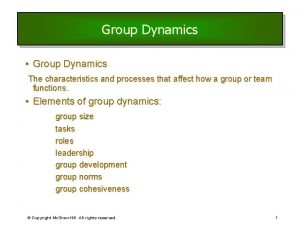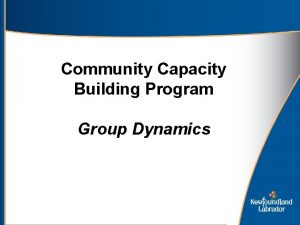Group Dynamics and Facilitated Workshops Simon French simon










































- Slides: 42

Group Dynamics and Facilitated Workshops Simon French simon. french@mbs. ac. uk

General Issues 2

A facilitator helps a group by. . . encouraging members to contribute; assuming responsibility for accurate communication; protecting minority views; being sensitive to unexpressed feelings and views; calming conflict by keeping the group task-oriented; summarising the position at appropriate points; generally, keeping the discussion moving and focused on the task in hand. 3

Process not Content In your mind, separate n process n content Your role is to watch, mind, smooth, catalyse and deliver the process. The content is not your responsibility. n n 4 Ideally you should be (or behave as if you are) ignorant of content. Volunteer content at your peril!

Key Tip Don’t volunteer content If the group needs content input Ask the group as a whole: ‘Are we clear on what we mean by …’ Ask a member of the group a (neutral) question If you must offer content, explicitly step out of role. 5

Clarify Objectives Be clear on: n n Project objectives Meeting objectives Explore and agree meeting objectives at the beginning of the meeting Use meeting objectives to focus process Evaluate meeting in terms of objectives at close 6

Key Tip When you feel lost, focus on the objectives 7

Live with the uncertainty You have to live with the uncertainty of the process. Your confidence gives the group the confidence to trust in your control of the process while they think about content. 8

Key Tip Be confident in success Always be (outwardly!) confident From the moment that the workshop is proposed At the beginning of the meeting During the meeting 9

Before the meeting 10

Initially Invite participants with letter n n n 11 objectives location, arrival and departure times no time-outs, no side meetings, no partial attendance Be clear on whose meeting it is Discuss confidentiality

Plan the environment Ensure everyone can see everyone n n n ‘face-to-face’ discussion tables get in the way Nameplates Chairs: comfortable enough n n not to fidget but not to sleep Analyst’s computer screen can distract n participants should only see projected output Know where the toilets are n 12 and ensure people can get to them quietly Have enough whiteboards/flipcharts n pens, post-its, blutac, … Break-out rooms n sign-posting Drinks, sweets, biscuits n n ease of reach no noisy wrapping papers Lighting, fresh air, heating n n Know the controls Watch during the meeting Above all, have some clear space in which to facilitate

Schedule refreshments, etc Build a broad plan of the meeting n n n Coffee Meal breaks ‘After lunch walk w As a group!!! n Evening w As a group!!! 13

Find out who is coming! You should know and welcome all participants Introduce yourself as they arrive but don’t get into deep conversation, especially about the content of the meeting 14

Beginning of Meeting 15

Opening Welcome everyone and thank them for coming n n making clear that you value their time get the sponsor to say some words of welcome Introduce team and roles Get them to introduce themselves n n maybe writing nameplates you need to be able to address each one individually Give rough (domestic) schedule of event Rules of event n Switch off mobiles! Warn them they are going to work. Explore and confirm meeting objectives 16

Brainstorm issues and concerns Brainstorm no evaluation Check lists as catalysts n n n SWOT PEST … Soft modelling section in Nadia and my notes. 17

Key Tip Get issues on the table before discussion At the opening of the meeting they will be unconstrained by any immediately previous discussion so get their first thoughts out without comment or evaluation. 18

During Meeting 19

Include everyone A non-contributor may have something to say! n n n May be shy There may be authority issues May be shut out by rest of group, who can guess what he or she is going to say! - And they don’t want to hear it!!!! 20

Recognise individuals The group has a ‘life’ of its own … … but recognise individuals as they are People can behave differently by the day/hour; they may not play consistent roles So watch their ‘characteristics’ throughout and communicate and interact accordingly. n n n 21 Belbin’s group roles Douglas’s cultural theory and risk attitude politically incorrect stereotypes

Belbin’s Roles (1) 22

Belbin’s Roles (2) 23

Belbin’s Roles (3) 24

Cultural Theory Individualist/Entrepreneurs: risks present opportunity, save those that threaten freedom of choice and action within free markets. Hierarchists: fear threats to social order and believe technological and environmental risks can be managed within set limits. Fatalists: do not knowingly accept risks but accept what is in store for them. Egalitarians: fear risks to the environment, the collective good and future generations. 25

Politically Incorrect Male/Female n Not always genetic!!! Racial/regional n n 26 Hofstede Wright/Phillips

Risk Perception and Communication Behavioural perception and response to risk not always Science-based n n Fright Factors (cancer, children, uncontrollable, unknown, …) experts are human too!!! Communication with public n n n 27 via media triggers (crime, cover-up, children at risk, incompetence) cival servants/politicians sensitive to media issues

Symbols, Icons, Words Watch for words or events that all (most) of the group react to Find out why there was a reaction n example: SWOT Threat Use/create such iconic events n 28 example: Shut in with problem

Key Tip Continually ask yourself: why are they saying that? Why is an individual behaving in that way? What is driving their (lack of? ) concern? How will they hear the words that I and others use? BUT also watch for those not saying anything! 29

Use white-boards, flip charts well Continually plan the layout n n will this information be needed later? does it relate to other material on another board? Use colour consistently Write clearly and n large enough to be read lowercase is easier to read than upper case Post-its can be moved! Have an assistant recording boards and key points for reports 30

Watch Schedule/Environment You are responsible for the n n room environment taking breaks outside noises Your task is to keep them task focused 31

Key Tip Continually ask yourself: Are they comfortable, awake, attentive? Is something physical in the room § discomforting them? § distracting them? Can they see/participate? If I am feeling it, they are! 32

Groupthink Causes n n n highly cohesive; insulated from many external influences; lacking in procedures for evaluating and reviewing alternatives; under the influence of a strong, directive leader; under some stress, e. g. urgency. Symptoms n n a false belief in the invulnerability of the group; a common belief in the innate morality of their decision; direct internal pressure to conform; an unquestioned and unanimous rationalisation of their choice. Treatment n 33 questions, questions!!!!

Drive, don’t lead! You need to keep the group n n focused creative but you should not lead Ask neutral questions initially and then questions that challenge ideas Indeed, try to work through questions so that they answer and it is their work. 34

Analysis – via questions Create conditions for communication Question questions Answer questions (run model) Question answers 35 Create understanding

Who represents the public? Once the meeting is going: n n group forms the ‘outside is no longer in the room’ So you represent the public and other stakeholders n n 36 via questions what would ? ? ? say if ? ? ?

Modelling Requisite n n n sufficient for task start simple and add! use sensitivity analysis Capture key understandings n and note capture Explain the model as you go n 37 and recap regularly

Key Tip If you get very lost: take a break! reflect on objectives take advice from your support team get some fresh air 38

End of meeting 39

Conclusion Summarise and agree conclusions Summarise and agree actions n what, who, when Reflect on meeting objectives and outcomes, but do not evaluate the group Agree on levels of confidentiality 40

Within 2 days … Thank you letter/email Action list Set expectations of next steps: n 41 when report will be available (soon!)

Final Tip Trust the group: give them the time and space and they will deliver 42
 Read 180 overview
Read 180 overview Psea retirement calculator
Psea retirement calculator Curious george mbti
Curious george mbti Cramped workshops set up in shabby tenement buildings
Cramped workshops set up in shabby tenement buildings Danio kwark gezond
Danio kwark gezond Can665.com
Can665.com Oracle licensing workshops
Oracle licensing workshops Double interview michelle garcia winner
Double interview michelle garcia winner Sayville learning center
Sayville learning center Google anay
Google anay Canadian bioinformatics workshops
Canadian bioinformatics workshops Bioinformatics.ca
Bioinformatics.ca Canadian bioinformatics workshops
Canadian bioinformatics workshops Canadian bioinformatics workshops
Canadian bioinformatics workshops Nonmembranous organelles
Nonmembranous organelles Facilitated diffusion and active transport
Facilitated diffusion and active transport 3 types of active transport
3 types of active transport What is facilitated diffusion in biology
What is facilitated diffusion in biology Facilitated tucking neonates
Facilitated tucking neonates Risk register
Risk register Bulk transport homework
Bulk transport homework Facilitated diffusion
Facilitated diffusion Facilitated collection
Facilitated collection Facilitated diffusion vs osmosis
Facilitated diffusion vs osmosis E. coli organelles
E. coli organelles Does facilitated diffusion require a transport protein
Does facilitated diffusion require a transport protein Sucrose facilitated diffusion
Sucrose facilitated diffusion Bioflix activity membrane transport facilitated diffusion
Bioflix activity membrane transport facilitated diffusion Syracuse facilitated communication
Syracuse facilitated communication Active transport
Active transport Facilitated diffusion sodium
Facilitated diffusion sodium Membrane protein
Membrane protein Is symport secondary active transport
Is symport secondary active transport Sodium facilitated diffusion
Sodium facilitated diffusion Facilitated diffusion
Facilitated diffusion Communication and interaction patterns
Communication and interaction patterns Maypole interaction pattern
Maypole interaction pattern What is deindividuation
What is deindividuation Function of group dynamics
Function of group dynamics Simon french raib
Simon french raib Flossies kitten rescue
Flossies kitten rescue Dynamics crm user group
Dynamics crm user group What is nature of organization
What is nature of organization
